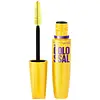What's inside
What's inside
 Key Ingredients
Key Ingredients

 Benefits
Benefits

 Concerns
Concerns

 Ingredients Side-by-side
Ingredients Side-by-side

Water
Skin ConditioningAcrylates Copolymer
Kaolin
AbrasiveCopernicia Cerifera Wax
PEG-15 Glyceryl Stearate
EmulsifyingSilica
AbrasiveButylene Glycol
HumectantAlcohol
AntimicrobialHydrogenated Rapeseed Alcohol
EmollientPolyvinyl Alcohol
Bentonite
AbsorbentDimethicone
EmollientStearic Acid
CleansingSucrose Distearate
EmollientVp/Va Copolymer
Simmondsia Chinensis Seed Oil
EmollientNylon-66
Simethicone
EmollientAminomethyl Propanediol
BufferingAminomethyl Propanol
BufferingXanthan Gum
EmulsifyingTocopherol
AntioxidantPhenoxyethanol
PreservativeChlorphenesin
AntimicrobialSodium Dehydroacetate
PreservativeIron Oxides
CI 77891
Cosmetic ColorantCI 77742
Cosmetic ColorantCI 19140
Cosmetic ColorantCI 77288
Cosmetic ColorantCI 77289
Cosmetic ColorantCI 75470
Cosmetic ColorantCI 77163
Cosmetic ColorantCI 42090
Cosmetic ColorantCI 77007
Cosmetic ColorantWater, Acrylates Copolymer, Kaolin, Copernicia Cerifera Wax, PEG-15 Glyceryl Stearate, Silica, Butylene Glycol, Alcohol, Hydrogenated Rapeseed Alcohol, Polyvinyl Alcohol, Bentonite, Dimethicone, Stearic Acid, Sucrose Distearate, Vp/Va Copolymer, Simmondsia Chinensis Seed Oil, Nylon-66, Simethicone, Aminomethyl Propanediol, Aminomethyl Propanol, Xanthan Gum, Tocopherol, Phenoxyethanol, Chlorphenesin, Sodium Dehydroacetate, Iron Oxides, CI 77891, CI 77742, CI 19140, CI 77288, CI 77289, CI 75470, CI 77163, CI 42090, CI 77007
Water
Skin ConditioningParaffin
PerfumingPotassium Cetyl Phosphate
EmulsifyingBeeswax
Emulsion StabilisingCopernicia Cerifera Wax
Acacia Senegal Gum
MaskingGlycerin
HumectantCetyl Alcohol
EmollientHydroxyethylcellulose
Emulsion StabilisingSodium Polymethacrylate
Emulsion StabilisingHydrogenated Jojoba Oil
AbrasiveHydrogenated Palm Oil
EmollientPhenethyl Alcohol
MaskingPhenoxyethanol
PreservativeSteareth-20
CleansingPEG/PPG-17/18 Dimethicone
EmulsifyingPolyquaternium-10
Silica
AbrasiveSoluble Collagen
HumectantSimethicone
EmollientPanthenol
Skin ConditioningDisodium EDTA
CI 77491
Cosmetic ColorantCI 77492
Cosmetic ColorantCI 77499
Cosmetic ColorantCI 77891
Cosmetic ColorantCI 77007
Cosmetic ColorantCI 77288
Cosmetic ColorantCI 77289
Cosmetic ColorantCI 77742
Cosmetic ColorantCI 77510
Cosmetic ColorantMica
Cosmetic ColorantWater, Paraffin, Potassium Cetyl Phosphate, Beeswax, Copernicia Cerifera Wax, Acacia Senegal Gum, Glycerin, Cetyl Alcohol, Hydroxyethylcellulose, Sodium Polymethacrylate, Hydrogenated Jojoba Oil, Hydrogenated Palm Oil, Phenethyl Alcohol, Phenoxyethanol, Steareth-20, PEG/PPG-17/18 Dimethicone, Polyquaternium-10, Silica, Soluble Collagen, Simethicone, Panthenol, Disodium EDTA, CI 77491, CI 77492, CI 77499, CI 77891, CI 77007, CI 77288, CI 77289, CI 77742, CI 77510, Mica
 Reviews
Reviews

Ingredients Explained
These ingredients are found in both products.
Ingredients higher up in an ingredient list are typically present in a larger amount.
This pigment is called Ultramarine blue lazurite. It gives a saturated blue color, but can be used to create other colors as well.
According to the manufacturer, it is usually made from kaolin, sodium sulfate, sodium carbonate, sulfur, and charcoal.
Ci 77288 is used to add green pigment to products.
We don't have a description for CI 77289 yet.
This ingredient is used to add a violet color to cosmetics.
It is created by reacting phosphoric acid, ammonium dihydrogen orthophosphate, and manganese dioxide.
Ci 77891 is a white pigment from Titanium dioxide. It is naturally found in minerals such as rutile and ilmenite.
It's main function is to add a white color to cosmetics. It can also be mixed with other colors to create different shades.
Ci 77891 is commonly found in sunscreens due to its ability to block UV rays.
Learn more about CI 77891Copernicia Cerifera Wax comes from a palm tree native to Brazil; another name for this ingredient is Carnauba Wax.
This ingredient is used to thicken texture and also leaves behind a film when applied.
Fun fact: This wax has the highest melting point of all natural waxes and low solubility.
Learn more about Copernicia Cerifera WaxPhenoxyethanol is a preservative that has germicide, antimicrobial, and aromatic properties. Studies show that phenoxyethanol can prevent microbial growth. By itself, it has a scent that is similar to that of a rose.
It's often used in formulations along with Caprylyl Glycol to preserve the shelf life of products.
Silica, also known as silicon dioxide, is a naturally occurring mineral. It is used as a fine, spherical, and porous powder in cosmetics.
Though it has exfoliant properties, the function of silica varies depending on the product.
The unique structure of silica enhances the spreadability and adds smoothness, making it a great texture enhancer.
It is also used as an active carrier, emulsifier, and mattifier due to its ability to absorb excess oil.
In some products, tiny microneedles called spicules are made from silica or hydrolyzed sponge. When you rub them in, they lightly polish away dead skin layers and enhance the penetration of active ingredients.
Learn more about SilicaSimethicone is a silicone. It is an emollient and used to reduce foaming in a product. It is also often used to coat sunscreen ingredients for better spreadability.
This ingredient is created by mixing dimethylpolysiloxane and hydrated silica.
Water. It's the most common cosmetic ingredient of all. You'll usually see it at the top of ingredient lists, meaning that it makes up the largest part of the product.
So why is it so popular? Water most often acts as a solvent - this means that it helps dissolve other ingredients into the formulation.
You'll also recognize water as that liquid we all need to stay alive. If you see this, drink a glass of water. Stay hydrated!
Learn more about Water